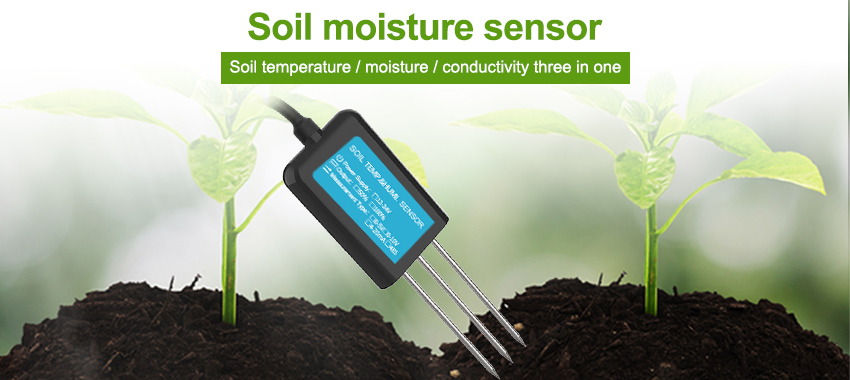Soil sensors are essential tools used to monitor and analyze soil parameters for various applications, including agriculture, environmental monitoring, and engineering. These sensors provide valuable information about soil moisture, temperature, nutrient levels, and other properties. Understanding the main types of soil sensors is crucial for selecting the appropriate sensor for specific applications. This article aims to provide an in-depth overview of the main types of soil sensors, their working principles, and their applications.

Capacitance-Based Soil Sensors
Capacitance-based soil sensors are widely used to measure soil moisture content. These sensors rely on the principle that the dielectric constant of soil changes with water content. The following are some key features of capacitance-based soil sensors:
1.1 Working Principle Capacitance-based soil sensors consist of two parallel metal plates, one of which is buried in the soil. When a voltage is applied to the plates, the capacitance between them changes depending on the soil’s water content. By measuring this change in capacitance, the sensor can estimate the soil’s moisture content.
1.2 Advantages
Accurate measurement of soil moisture content.
Suitable for a wide range of soil types.
Long-term stability and durability.
Can be integrated with data loggers for continuous monitoring.
1.3 Limitations
Susceptible to electrical interference and stray capacitance.
Requires regular calibration for accurate readings.
Not suitable for soils with high electrical conductivity or salinity.
1.4 Applications
Irrigation management in agriculture.
Soil moisture monitoring for research purposes.
Environmental monitoring and water resource management.
Time Domain Reflectometry (TDR) Soil Sensors
2.1 Working Principle TDR soil sensors emit an electromagnetic pulse into the soil and measure the time it takes for the pulse to reflect back to the sensor. By analyzing the time delay, the sensor can determine the soil’s moisture content.
Time Domain Reflectometry (TDR) soil sensors are commonly used to measure soil moisture content. These sensors utilize the principle that electromagnetic waves propagate through the soil at different speeds depending on the soil’s moisture content. The following are some key features of TDR soil sensors:
2.2 Advantages
Accurate measurement of soil moisture content.
Suitable for a wide range of soil types.
Can provide depth-specific soil moisture profiles.
Can be integrated with data loggers for continuous monitoring.
2.3 Limitations
Requires precise calibration for accurate readings.
Expensive compared to other soil sensors.
Limited sensitivity to low moisture contents.
2.4 Applications
Precision irrigation management in agriculture.
Soil moisture monitoring for ecological research.
Landslide monitoring and slope stability analysis.

Electrical Conductivity (EC) Soil Sensors
Electrical Conductivity (EC) soil sensors are used to measure soil electrical conductivity, which provides information about soil salinity and nutrient levels. The following are some key features of EC soil sensors:
3.1 Working Principle EC soil sensors pass a small current through the soil and measure the resulting voltage drop. By analyzing the voltage drop, the sensor can estimate the soil’s electrical conductivity and, consequently, its salinity and nutrient levels.
3.2 Advantages
Provides information on soil salinity and nutrient levels.
Suitable for a wide range of soil types.
Can be integrated with data loggers for continuous monitoring.
Relatively inexpensive compared to other soil sensors.
3.3 Limitations
Susceptible to interference from soil temperature variations.
Electrical conductivity may not directly correlate with specific nutrient levels.
Requires regular calibration for accurate readings.
3.4 Applications
Soil salinity monitoring in agricultural fields.
Nutrient management in precision agriculture.
Environmental monitoring of soil pollution.
Optical Soil Sensors
Optical soil sensors are used to measure various soil properties, including moisture content, organic matter content, and pH. These sensors utilize optical principles to estimate soil parameters. The following are some key features of optical soil sensors:
4.1 Working Principle Optical soil sensors use different optical techniques such as reflectance, absorption, or fluorescence to measure soil properties. For example, Near-Infrared (NIR) sensors can estimate soil moisture and organic matter content based on the absorption and reflection of NIR light by soil particles.
4.2 Advantages
- Non-destructive measurement technique.
- Can provide multiple soil parameter measurements simultaneously.
- Suitable for a wide range of soil types.
- Can be integrated with data loggers for continuous monitoring.
4.3 Limitations
- Requires calibration for accurate readings.
- Susceptible to interference from soil surface conditions.
- Limited sensitivity in certain soil types.
4.4 Applications
- Precision irrigation management in agriculture.
- Soil quality assessment for land use planning.
- Environmental monitoring and pollution studies.
Conclusion
Soil sensors play a crucial role in monitoring and analyzing soil properties for various applications. Capacitance-based, TDR, EC, and optical soil sensors are among the main types used to measure soil moisture, electrical conductivity, and other parameters. Each type has its advantages, limitations, and specific applications. Understanding the working principles and applications of these soil sensors is essential for selecting the most suitable sensor for specific needs, whether it be precision agriculture, environmental monitoring, or engineering projects. By harnessing the capabilities of soil sensors, accurate and reliable information about soil properties can be obtained, leading to improved land management practices and sustainable resource utilization.
